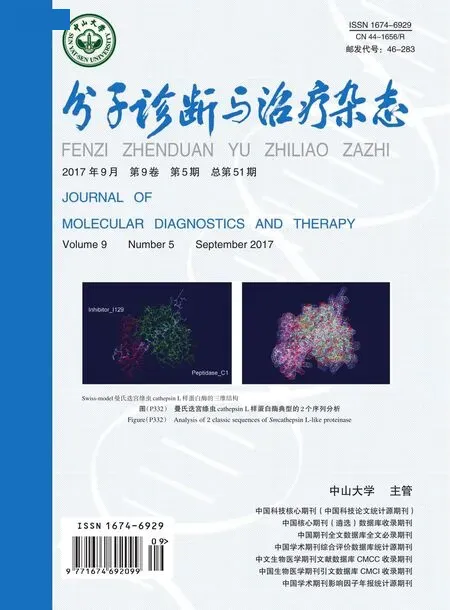32 497例正常听力孕龄女性耳聋基因携带率与突变谱调查
刘畅 张彦 丁红珂 吴菁 麦明琴 曾玉坤 刘玲 尹爱华★
32 497例正常听力孕龄女性耳聋基因携带率与突变谱调查
刘畅1,2张彦1,2丁红珂1,2吴菁1麦明琴1曾玉坤1,2刘玲1,2尹爱华1,2★
目的在正常听力孕龄人群中开展耳聋基因携带率与突变谱调查,为耳聋基因筛查、遗传咨询、疾病管理提供数据。方法32 497例听力正常且无耳聋家族史的孕龄女性在我院医学遗传中心门诊接受遗传咨询后,接受耳聋基因芯片筛查。对于检测结果提示为常染色体隐性遗传耳聋基因突变携带者,建议其配偶进行进一步耳聋基因检测。对于夫妇均为耳聋基因突变携带的家庭,给予遗传咨询与风险评估,必要时提供产前耳聋基因诊断。结果32 497位听力正常且无耳聋家族史的孕龄女性中,1 181例携带遗传性耳聋基因突变,携带率为3.63%。其中,1 117例携带常染色体隐性遗传的耳聋基因杂合突变,包括4种常见的GJB2基因突变665例,2种常见的SLC26A4基因突变407例,GJB3基因突变45例。此外,64例携带与氨基糖甙类药物诱导性耳聋密切相关的线粒体DNA12S rRNA基因突变。结论在正常听力的孕龄人群中开展耳聋基因携带率与突变谱的研究,对优生优育与遗传咨询具有重要意义。
耳聋;携带率;突变谱
耳聋是临床上常见的出生缺陷,每1 000名活产儿中便有 1~3 名新生聋儿[1⁃2]。由于幼儿期是大脑语言中枢发育的重要时期,在这一时期未获得充分的听觉刺激及语言接触的孩童将面临包括语言获取、认知发展、社会心理及社会交往等多方面的障碍[3⁃4]。过半数的语前聋患儿系由遗传性因素所导致的耳聋。鉴于90%~95%的聋病患儿出生于听力正常的家庭[5],在听力正常人群中进行耳聋基因突变携带率与分布情况的调研十分重要,可为耳聋基因筛查、遗传咨询、疾病管理提供流行病学数据[6]。本研究拟在听力正常的孕龄人群中开展耳聋基因携带率与突变谱的调查,为遗传咨询与生育指导提供资料。
1 材料与方法
1.1 一般资料
本临床研究将2011年1月至2016年4月间在广东省妇幼保健院医学遗传中心门诊寻求孕前/孕早期检查与遗传优生咨询的32 497例听力正常且无耳聋家族史的孕龄女性纳入研究范围,入组人群年龄介于20~40岁,以中国南方人群为主。研究方法和研究对象入组标准经广东省妇幼保健院伦理委员会审核通过。临床上对入组个体进行病史收集及体格检查,包括详细的过往病史、耳聋家族史、不良孕产史、氨基糖甙类药物接触史以及与耳聋相关的潜在致病因素。受检者在充分知情同意情况下,签署知情同意书。
1.2 方法
1.2.1 耳聋基因检测
采集受检者外周血2 mL,提取基因组DNA。使用微阵列芯片法晶芯®九项遗传性耳聋基因检测试剂盒[北京博奥生物有限公司,国食药监械(准)字2009第3400725]对受检者进行GJB2基因c.35 del G、c.176_191 del 16 bp、c.235 del C、c.299_300 delAT,GJB3基 因 c.538 C>T,SLC26A4基因 c.2168 A>G、c.919_2 A>G,线粒体DNA12S rRNA基因m.1494 C>T、m.1555 A>G等中国人群耳聋基因突变热点筛查。根据试剂盒说明书,通过多重不对称等位基因特异性PCR扩增获得大量单链DNA,PCR产物变性后与芯片杂交,芯片洗涤后经晶芯LuxScan10K⁃B微阵列芯片扫描仪扫描成像并使用配套软件进行结果判读。
1.2.2 遗传咨询及生育指导
根据耳聋基因检测结果给予受检者相应的遗传咨询意见[7⁃8]。对于检测结果提示为常染色体隐性遗传耳聋基因突变携带者,建议其配偶进行进一步耳聋基因检测。如夫妇均携带同一常染色体隐性遗传耳聋基因上的致病突变,则可为其提供遗传风险分析及生育指导,包括胚胎植入前诊断、接受捐赠配子、产前基因诊断等。对于检测结果提示为线粒体遗传耳聋基因突变携带者,遗传咨询中需就其母系遗传方式及其与药物诱导性耳聋间的关系进行充分告知,给予用药指导。
2 结果
经检测,本研究所收集的32 497例听力正常且无耳聋家族史的孕龄女性中,1 181例携带遗传性耳聋基因突变,即9种常见致聋基因突变在该人群中的携带率为3.63%。如表1所示,1 181例耳聋基因突变携带者中,1 117例携带常染色体隐性遗传的耳聋基因杂合突变。包括4种常见的GJB2基因突变665例,携带率2.05%;2种常见的SLC26A4基因突变407例,携带率1.25%;GJB3基因突变45例,携带率0.14%。此外,遵循母系遗传规律的线粒体DNA12S rRNA基因突变64例,携带率0.20%。
1 117例携带常染色体隐性遗传耳聋基因突变的孕龄女性与配偶一同接受遗传咨询后,735位携带者配偶选择接受进一步耳聋基因检测,包括9种中国人群常见的致聋基因突变位点的芯片检测以及配偶所携带致病基因的外显子序列分析。检测结果提示47对夫妇为相同隐性遗传耳聋基因的突变携带者,根据遗传规律,他们的后代出现致病基因纯合突变的概率约为25%。在接受详细的遗传咨询,并充分了解手术风险与检测局限性的情况下,44对携带致聋突变的夫妇选择了产前耳聋基因诊断。检测结果提示,10例胎儿未携带致聋突变、25例携带杂合致聋突变、9例携带纯合致聋突变或复合杂合突变。根据产前耳聋基因诊断的结果,遗传咨询医师为各家庭提供相应的遗传咨询意见及生活指导。孩子出生后听力评估结果与产前诊断结果相符,我们对孩子的情况进行了定期随访并给予恰当的生活指导[9]。此外,3对携带常染色体隐性遗传致聋基因突变的夫妇经充分知情告知后,选择不进行产前耳聋基因诊断。其中一对夫妇生育听力缺失患儿,我们为其提供了早期诊断、干预及援助信息[10]。
此外,本次正常听力孕龄女性耳聋基因筛查中检出线粒体DNA12S rRNA基因突变携带者64例。鉴于线粒体DNA12S rRNA基因突变是氨基糖甙类药物诱导性耳聋的重要遗传机制[11],且遵循母系遗传模式,我们为突变携带者及其母系亲属提供了详细的用药指导。

表1 32 497例正常听力孕龄女性人群耳聋基因携带率与突变谱调查Table 1 The carrier rate and mutation spectrum of genes associated with hearing loss in 32 497 hearing female of childbearing age
3 讨论
本研究中32 497例听力正常的孕龄女性中1 181例携带遗传性耳聋基因突变,该人群中致聋基因突变的携带率为3.63%。本研究样本量较大、入组标准执行严格,因此数据具有较好的代表性与可信度,可为耳聋基因筛查、遗传咨询、疾病管理提供重要数据资料[12]。同时,了解孕龄人群耳聋基因突变携带率与分布情况,有助于选择中国人群中携带率较高、临床表现较重、诊断意义较大的耳聋基因突变位点作为孕前/孕早期耳聋基因筛查的检测位点。
基于该听力正常孕龄女性人群的耳聋基因突变率与携带谱研究,4种常见的GJB2基因突变占检出的基因突变比例为56.31%,其中高加索人群中携带率最高的致聋基因突变GJB2基因c.35 del G在该主要由中国南方人组成的人群研究中携带率较低,仅占检出突变的0.34%;而在中国耳聋病患群体中检出率最高的致聋突变GJB2基因c.235 del C位点[13]在本研究的听力正常人群中携带率也居首位,约占检出变异的46.66%。此外,在该听力正常人群中SLC26A4基因上2种常见致聋突变c.2168 A>G与c.919⁃2 A>G检出率也较高,共占检出突变的34.46%。而GJB3基因上的耳聋相关变异c.538 C>T位点则在中国南方人群中携带率较低,约占检出突变的3.81%。此外,与氨基糖甙类药物诱导性耳聋关系密切的线粒体DNA12S rRNA基因变异m.1494 C>T与m.1555 A>G位点约占检出突变的5.42%。
耳聋的发病率在活产儿中高达1‰~3‰,且90%~95%耳聋患儿出生于父母听力正常的家庭,因而在听力正常的孕龄人群中进行致聋基因携带率与突变谱的研究十分重要,可为耳聋基因筛查、遗传咨询、疾病管理提供重要数据资料。
[1]Wu CC,Tsai CH,Hung CC,et al.Newborn genetic screening for hearing impairment:a population⁃based longitudinal study[J].Genet Med,2016.[Epub ahead of print]
[2]Peng Q,Huang S,Liang Y,et al.Concurrent genetic and standard screening for hearing impairment in 9317 Southern Chinese newborns[J].Genet Test Mol Bio⁃markers,2016,20(10):603⁃608.
[3]Yoshinaga⁃Itano C,Wiggin M.A look into the crystal ball for children who are deaf or hard of hearing:needs, opportunities, and challenges [J].Semin Speech Lang,2016,37(4):252⁃258.
[4]Ching TY,Crowe K,Martin V,et al.Language de⁃velopment and everyday functioning of children with hearing loss assessed at 3 years of age[J].Int J Speech Lang Pathol,2010,12:124⁃131.
[5]Mitchell RE,Karchmer MA.Chasing the mythical ten percent:parental hearing status of deaf and hard of hearing students in the United States[J].Sign Lan⁃guage Stud,2004,4:138⁃163.
[6]Yin A,Liu C,Zhang Y,et al.The carrier rate and mutation spectrum of genes associated with hearing loss in South China hearing female population of child⁃bearing age[J].BMC Med Genet,2013,14:57.
[7]Yin A,Liu C,Zhang Y,et al.Genetic counseling and prenatal diagnosis for hereditary hearing loss in high⁃risk families[J].Int J Pediatr Otorhinolaryngol,2014,78(8):1356⁃1359.
[8]刘畅,丁红珂,吴菁,等.遗传性耳聋的产前诊断与遗传咨询[J].中国产前诊断杂志(电子版),2015,7(4):35⁃39.
[9]Hunter LL,Meinzen⁃Derr J,Wiley S,et al.Influence of the WIC program on loss to follow⁃up for newborn hearing screening [J].Pediatrics,2016,138(1):e20154301.
[10]Ravi R,Gunjawate DR,Yerraguntla K,et al.Follow⁃up in newborn hearing screening⁃a systematic review[J].Int J Pediatr Otorhinolaryngol,2016,90:29⁃36.
[11]Wu J,Hao Z,Fu D,et al.Mitochondrial mutations associated with aminoglycoside ototoxicity and hearing loss susceptibility identified by meta⁃analysis[J].J Med Genet,2015,52(2):95⁃103.
[12]袁永一,戴朴.遗传性聋的精准医疗[J].临床耳鼻咽喉头颈外科杂志,2016,30(1):1⁃5.
[13]Dai P,Yu F,Han B,et al.GJB2 mutation spectrum in 2,063 Chinese patients with nonsyndromic hearing impairment[J].J Transl Med,2009,7:26.
Investigation on gene carrying rate and mutation spectrum of deafness in 32 497 cases of childbearing⁃age women with normal hearing
LIU Chang1,2,ZHANG Yan1,2,DING Hongke1,2,WU Jing1,MAI Mingqin1,ZENG Yukun1,2,LIU Ling1,2,YIN Aihua1,2★
(1.Medical Genetic Center,Guangdong Women and Children Hospital,Guangzhou,Guangdong,China,511400;2.Maternal and Children Metabolic⁃Genetic Key Laboratory,Guangdong Women and Children Hospital,Guangzhou,Guangdong,China,511400)
ObjectiveTo better understand the carrier rate and mutation spectrum of genes associated with hearing impairment in the general population,which could be of importance in carrier screening,genetic counseling,and disease management.Methods32 497 unrelated women of childbearing age with normal hearing and without family history of hearing loss were tested with allele⁃specific PCR⁃based universal array.Further genetic tests were provided to the spouses of the screened carriers.For those couples at risk,multiple choices were provided,including prenatal diagnosis.ResultsAmong the 32 497 normal hearing participants,1 181 subjects carried pathogenic mutations included in the screening chip,which had the carrier rate 3.63%.A total of 665 participating subjects carried one type of the 4 common deafness⁃causing mutations inGJB2gene in the heterozygous state,407 subjects were found carrying one type of the 2 confirmed pathogenic mutations inSLC26A4gene in the heterozygous state,and 45 subjects were found carrying pathogenic mutation inGJB3gene in the heterozygous state.In addition,64 participants were detectedto be homoplasmic mutation carriers of mitochondrial DNA12S rRNAgene,which was important mechanism of genetic susceptibility to aminoglycoside ototoxicity.ConclusionBetter understanding about the carrier rate and mutation spectrum of genes associated with hearing impairment in the general population of childbearing age might be important for carrier screening and genetic counseling.
Hearing loss;Carrier rate;Mutation spectrum
作者单位:1.广东省妇幼保健院医学遗传中心,广东,广州511400
2.广东省妇幼保健院妇幼代谢与遗传重点实验室,广东,广州511400
广东省医学科学技术研究基金项目(A2016225)
★通讯作者:尹爱华,E⁃mail:yinaiwa@vip.126.com

